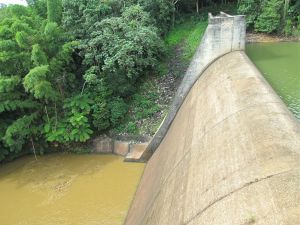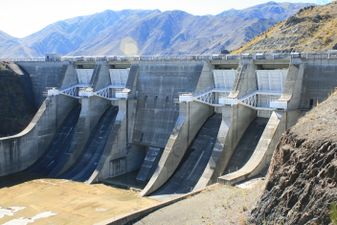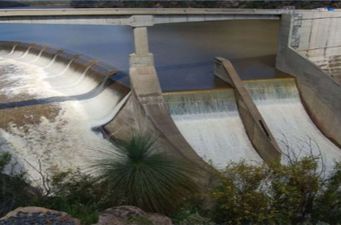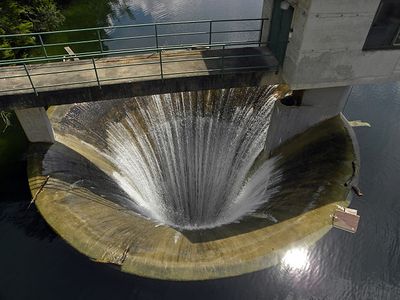Spillway: Difference between revisions
m (1 revision imported) |
m (1 revision imported) |
||
| (One intermediate revision by one other user not shown) | |||
| Line 1: | Line 1: | ||
[[Category:Done | [[Category:Done 2021-01-31]] | ||
[[File:Miho_Dam_spillway.jpg|360px|thumb|right|Figure 1. The spillway on the Miho Dam.<ref>Wikimedia Commons. (August 28, 2015). ''Miho Dam Spillway'' [Online]. Available: https://upload.wikimedia.org/wikipedia/commons/9/9c/Miho_Dam_spillway.jpg</ref>]] | [[File:Miho_Dam_spillway.jpg|360px|thumb|right|Figure 1. The spillway on the Miho Dam.<ref>Wikimedia Commons. (August 28, 2015). ''Miho Dam Spillway'' [Online]. Available: https://upload.wikimedia.org/wikipedia/commons/9/9c/Miho_Dam_spillway.jpg</ref>]] | ||
| Line 8: | Line 8: | ||
==Types== | ==Types== | ||
Spillways can be either controlled or uncontrolled, and they function differently depending on their type. Controlled spillways are equipped with gates that can be raised or lowered. Uncontrolled spillways do not have this gate. Regardless of what specific type of spillway is used, they generally consist of a control structure to hold back water, a channel for water to flow through, and a terminal structure. | Spillways can be either controlled or uncontrolled, and they function differently depending on their type. Controlled spillways are equipped with gates that can be raised or lowered. Uncontrolled spillways do not have this gate. Regardless of what specific type of spillway is used, they generally consist of a control structure to hold back water, a channel for water to flow through, and a terminal structure. | ||
<gallery caption="Gallery of Spillways" mode=packed heights=150px> | |||
File:Cidra Spillway-ogee.jpg|400px|Ogee spillway (Cidra Dam)<ref>"Cidra Spillway," August 10, 2012. [Online], Available: https://whenlifegivesyoucookies.wordpress.com/2012/08/10/puerto-rico-day-2/img_0147/#main</ref> | |||
File:chute spillway.jpg|400px|Chute spillway (Benmore Earth Dam)<ref>Wikimedia Commons [Online], Available: https://commons.wikimedia.org/wiki/File:Benmore_(Earth)_Dam,_Spillway_Gates_-_panoramio.jpg</ref> | |||
File:picture of side channel spillway.JPG|400px|Side-channel spillway<ref>"Spillways components and types," March 19, 2018. [Online], Available: https://image.slidesharecdn.com/spillwaysfinalppt-180319085104/95/spillways-components-and-types-30-638.jpg?cb=1521449546</ref> | |||
</gallery> | |||
<gallery mode=packed heights=200px> | |||
File:bell mouth spillway.jpg|400px|Bell-mouth spillway (Erlauf-Stausee Lake)<ref>Wikimedia Commons [Online], Available: https://commons.wikimedia.org/wiki/File:Naturpark_%C3%96tscher-Torm%C3%A4uer_-_Erlaufstausee_%C3%9Cberlauf.jpg</ref> | |||
File:Siphon spillway of Chopyeong Dam in South Korea.jpg|400px|Siphon spillway (Chopyeong Dam)<ref>Wikimedia Commons [Online], Available: https://commons.wikimedia.org/wiki/File:%EC%B4%88%ED%8F%89%EB%8C%90_%EC%82%AC%EC%9D%B4%ED%8E%80_%EC%97%AC%EC%88%98%EB%A1%9C.jpg</ref> | |||
</gallery> | |||
===Ogee Spillway=== | ===Ogee Spillway=== | ||
This type of spillway is a part of the dam itself, provided that the dam is tall enough. This type of spillway directs water to the water below the dam, releasing it on the same level as the water below.<ref name="RE1"/> | This type of spillway is a part of the dam itself, provided that the dam is tall enough. This type of spillway directs water to the water below the dam, releasing it on the same level as the water below.<ref name="RE1"/> | ||
Latest revision as of 19:13, 15 October 2021

A spillway is a structure constructed in a hydroelectric dam to provide a safe path for floodwaters to escape to some downstream area. Generally, the area that the spillway is released to is the river on which the hydroelectric dam was constructed.[2] These spillways are an important functional part of a hydroelectric facility. If there is too much water going through the dam, elements like the turbines cannot function properly and can be damaged. Spillways protect these other parts from damage or complications.
Every hydroelectric reservoir has a certain capacity or amount of water it can hold. If the reservoir is already full but floodwaters enter the reservoir, the water level will increase and this could result in the over-topping of the dam. Spillways are built to prevent this, as it allows some water to be drawn from the top of the reservoir to make room for the new water. When a reservoir is full, its water level will be equal to the height of the spillway. As soon as any excess water enters the reservoir, water will immediately start flowing out through the spillway.
Types
Spillways can be either controlled or uncontrolled, and they function differently depending on their type. Controlled spillways are equipped with gates that can be raised or lowered. Uncontrolled spillways do not have this gate. Regardless of what specific type of spillway is used, they generally consist of a control structure to hold back water, a channel for water to flow through, and a terminal structure.
- Gallery of Spillways
Ogee spillway (Cidra Dam)[3]
Chute spillway (Benmore Earth Dam)[4]
Side-channel spillway[5]
Ogee Spillway
This type of spillway is a part of the dam itself, provided that the dam is tall enough. This type of spillway directs water to the water below the dam, releasing it on the same level as the water below.[2]
Chute Spillway
This type of spillway has a small crest that water must flow over. After moving over this crest, the water is moved down through a chute or trough to the downstream side of the river. This type of spillway can be close to the dam, or some distance away where conditions are better.[2]
Side Channel Spillway
These spillways are located upstream and to the side of the dam. After flowing over a control crest, water enters a side channel and is carried to the downstream side of the dam by a chute. Occasionally tunnels are used instead of a chute.[2]
Bell-Mouth Spillway
When a dam is overflowing, water moves into a spill-over area. In this area there is a hole in the bottom of the holding container, allowing water to fall into the opening on all sides. This then drains the water in an uncontrolled manner.[2]
Siphon Spillway
This type of spillway uses a height difference between the intake and the output area to create a pressure difference that removes excess water. This type of spillway is able to discharge large amounts of water.[2]
For Further Reading
References
- ↑ Wikimedia Commons. (August 28, 2015). Miho Dam Spillway [Online]. Available: https://upload.wikimedia.org/wikipedia/commons/9/9c/Miho_Dam_spillway.jpg
- ↑ 2.0 2.1 2.2 2.3 2.4 2.5 Civil Engineering Dictionary. (August 28, 2015). Spillway Definition [Online]. Available: http://www.aboutcivil.org/spillway-definition-types-classification.html
- ↑ "Cidra Spillway," August 10, 2012. [Online], Available: https://whenlifegivesyoucookies.wordpress.com/2012/08/10/puerto-rico-day-2/img_0147/#main
- ↑ Wikimedia Commons [Online], Available: https://commons.wikimedia.org/wiki/File:Benmore_(Earth)_Dam,_Spillway_Gates_-_panoramio.jpg
- ↑ "Spillways components and types," March 19, 2018. [Online], Available: https://image.slidesharecdn.com/spillwaysfinalppt-180319085104/95/spillways-components-and-types-30-638.jpg?cb=1521449546
- ↑ Wikimedia Commons [Online], Available: https://commons.wikimedia.org/wiki/File:Naturpark_%C3%96tscher-Torm%C3%A4uer_-_Erlaufstausee_%C3%9Cberlauf.jpg
- ↑ Wikimedia Commons [Online], Available: https://commons.wikimedia.org/wiki/File:%EC%B4%88%ED%8F%89%EB%8C%90_%EC%82%AC%EC%9D%B4%ED%8E%80_%EC%97%AC%EC%88%98%EB%A1%9C.jpg






